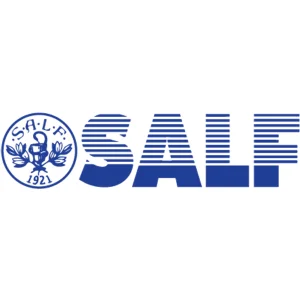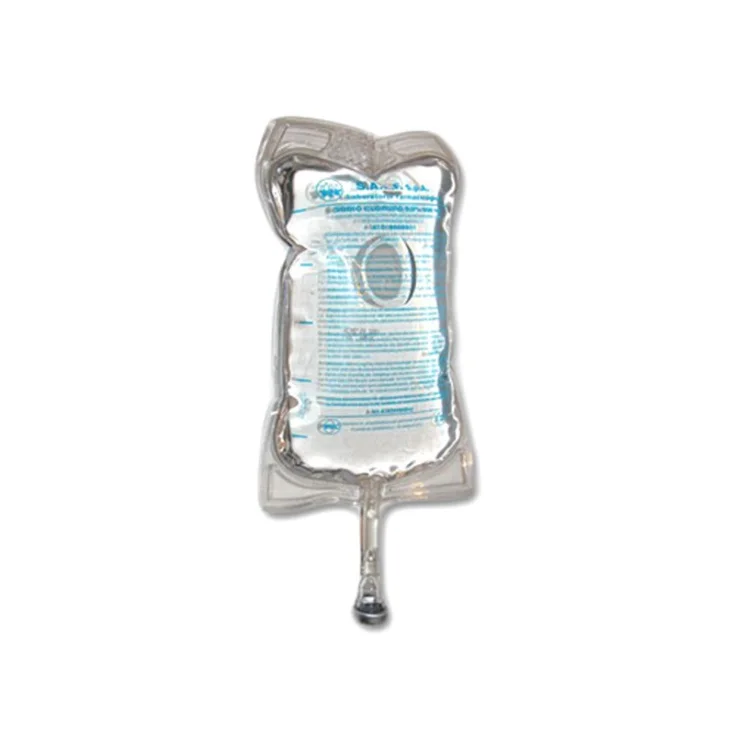Sodium Chloride SALF 0.9% Physiological Solution Bag 1000ml

- Brand: SALF SpA
- Product Code: 030684551
- EAN:
- Availability: In 10 - 14 Days
- 3 items
for 4,34€ each - 4 items
for 4,25€ each - 5 items
for 4,16€ each
Sodium Chloride SALF 0.9%
NAME
SODIUM CHLORIDE SALF
ACTIVE PRINCIPLES
1000 ml contain: Active ingredient: sodium chloride 9 g. mEq / l: Na + 154 mEq / l: Cl– 154 Theoretical osmolarity (mOsm / l): 308 pH: 4.5 - 7.0 1 g of NaCl = 394 mg of Na + or 17.1 mEq or 17, 1 mmol of Na + and Cl– 1 mmol Na + = 23 mg of Na + For the full list of excipients, see section 6.1.
EXCIPIENTS
Water for injections.
THERAPEUTIC INDICATIONS
Reintegration of fluids and sodium chloride.
CONTRAINDICATIONS / UNDESIRABLE EFFECTS
Hypernatremia. Hydrosaline flask.
DOSAGE
The medicinal product should be administered by intravenous infusion. Treatment of isotonic fluid depletion (extracellular dehydration) Adults and adolescents: from 500 ml to 3 liters in 24 hours. Infants and children (up to 12 years of age): 20 to 100 ml in 24 hours and per kg of body weight, depending on age and total body weight. Dosage should be appropriately reduced in patients with renal insufficiency. Treatment of sodium deficiency The dose is dependent on age, weight, clinical condition, electrolyte picture and osmolarity, and is related to the calculated sodium deficit. The theoretical sodium deficit can be calculated using the following formula: DEFICIT (mEq) = (140 - P) x VP = plasma sodium concentration (in mEq / l) V = volume of body water (equal to 60% of body weight for children and adult males, 50% for adult women, 50% and 45% for older men and women respectively). Using hypertonic solutions (2% - 3% - 5%), administer half the dose in the first 8 hours up to a maximum of 100 ml / hour; then administer the remaining dose until a plasma sodium concentration of 130 mEq / l or until symptoms improve. In conditions of severe sodium depletion and in the treatment of severe symptoms related to chronic hyponatremia, administer hypertonic sodium chloride solutions to increase the plasma sodium concentration by 1–2 mmol / l / hour. Make sure that the correction does not exceed 10-12 mmol / l in 24 hours and 18 mmol / l in 48 hours. In the event that the sodium chloride solutions, and in particular the 0.9% solutions, are used as diluting solutions for the intravenous administration of drugs that must be previously diluted, check in advance the compatibility of these medicines with sodium chloride and its concentration. most suitable for administration in the SmPC of the drug to be diluted. If the concentration is not indicated, use the 0.9% solution.
STORAGE
Store in tightly closed container. Do not freeze or refrigerate. The solution should be clear, colorless and free from visible particles.
WARNINGS
Sodium salts should be administered with caution in patients with hypertension, heart failure, peripheral or pulmonary edema, impaired renal function, pre-eclampsia, or other conditions associated with sodium retention (see section 4.5). Solutions with concentrations higher than 0.9% (hypertonic solutions) must be used with caution, at a controlled rate of infusion and only in cases where they are specifically prescribed. Use with great caution in patients with congestive heart failure, severe renal insufficiency and in clinical states where there is edema with salt retention; in patients being treated with corticosteroid or corticotropin drugs. Continuous administration without the addition of potassium may cause hypokalaemia. Use with caution in children. During the infusion it is good practice to monitor the fluid balance, electrolytes, plasma osmolarity and acid-base balance. The solution should be clear, colorless and free from visible particles. Use immediately after opening the container. The container is for one uninterrupted administration and any residue cannot be used.
INTERACTIONS
Corticosteroids are associated with sodium and water retention, resulting in edema and hypertension: therefore, caution should be exercised in the simultaneous administration of sodium salts and corticosteroids (see section 4.4). Although sodium chloride is compatible with a large number of solutions and medicines, it is still advisable to check its compatibility in the SmPC of the medicine you intend to co-administer.
SIDE EFFECTS
The following are the undesirable effects of sodium chloride, organized according to the MedDRA system organ class. Insufficient data are available to establish the frequency of the individual effects listed. Disorders of water and electrolyte balance Hypernatremia, hypervolemia, plasma hypoosmolarity (for 0.45% solutions), hyperchloraemia (which can cause a loss of bicarbonates resulting in acidosis) Nervous system disorders Headache, dizziness, restlessness, fever, irritability, weakness, muscle stiffness, convulsions, coma, death Psychiatric disorders Somnolence, confusional states Respiratory, thoracic and mediastinal disorders Dyspnoea, respiratory arrest. Gastrointestinal disorders Thirst, decreased salivation, nausea, vomiting, diarrhea, abdominal pain. Cardiac disorders Tachycardia. Eye disorders Reduced lacrimation. Renal and urinary disorders Renal failure. Vascular disorders Hypotension, hypertension, pulmonary and peripheral edema. General disorders and administration site conditions Infusion site infection, local pain or reaction, venous irritation, thrombosis or venous phlebitis extending from the infusion site, extravasation.
OVERDOSE
Symptoms The 0.45% solution is hypotonic with the blood and determines a reduction in plasma osmolarity: overdose can therefore lead to plasma hypoosmolarity. The administration of excessive doses of isotonic and hypertonic sodium chloride solutions can lead, depending on the clinical condition of the patient, to hypernatremia, hyperchloraemia and / or hypervolemia. Hypernatremia (mainly associated with the administration of hypertonic solutions) and excessive sodium retention where there is a defective excretion of sodium in the kidney determines dehydration of the internal organs, especially the brain, and the accumulation of extracellular fluids with edema that they can affect the cerebral, pulmonary and peripheral circulation with the appearance of pulmonary and peripheral edema. The accumulation of chlorine ions causes a reduction in the concentration of bicarbonate ions leading to acidosis. Treatment In case of accidental excessive infusion, the treatment must be suspended and the patient must be kept under observation to assess the appearance of any signs and symptoms related to the drug administered, guaranteeing the patient the relative symptomatic and support measures as needed. In the event of an overdose, therapy should be aimed at restoring physiological concentrations of the sodium ion. In these cases, intravenous administration of 5% glucose or hypotonic or isotonic sodium chloride solutions (as they are hypotonic for the hypernatremic patient) is recommended. In case of elevated natremia, loop diuretics can be used. A natremia greater than 200 mmol / L may require the use of dialysis.
PREGNANCY AND BREASTFEEDING
Although no effects on the development of the fetus have been highlighted, the medicine should be administered only in case of real need and only after having evaluated the risk / benefit ratio with your doctor. The medicine is compatible with breastfeeding.
Format: 1000ml bag






